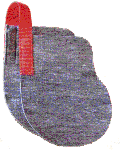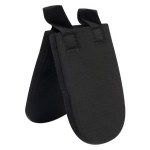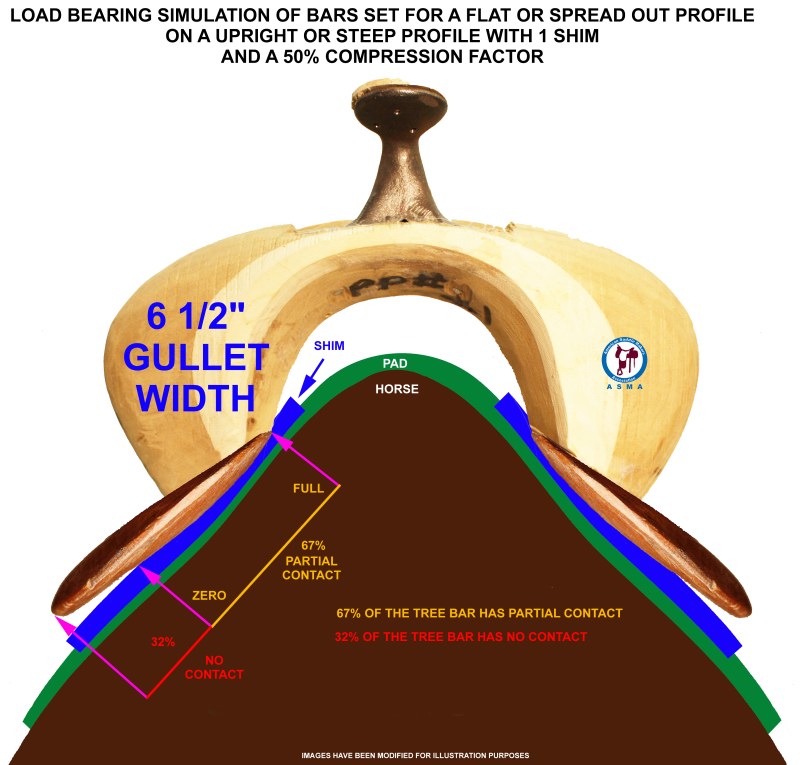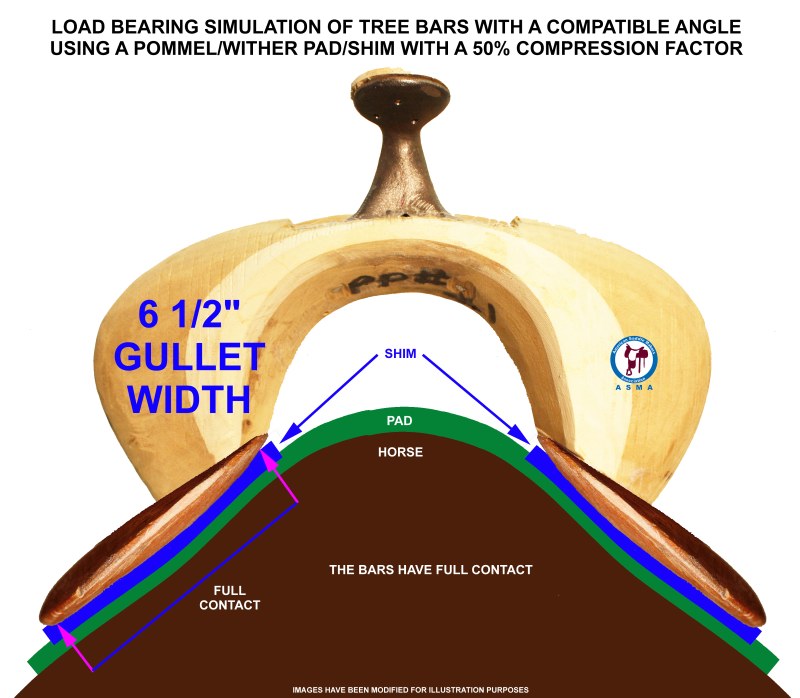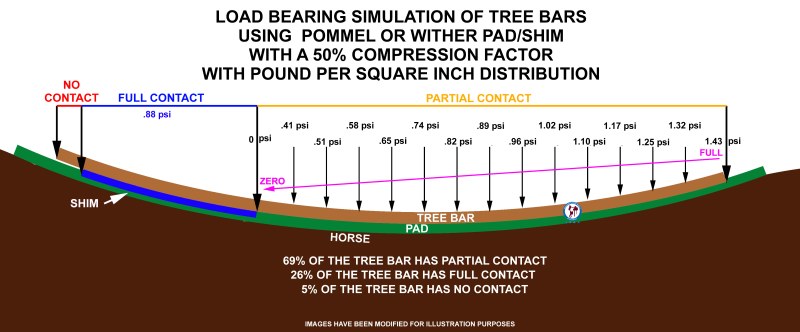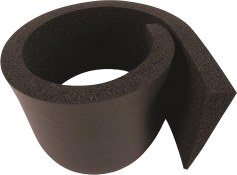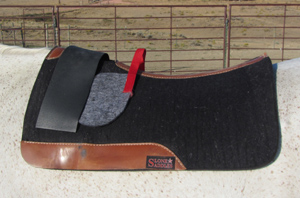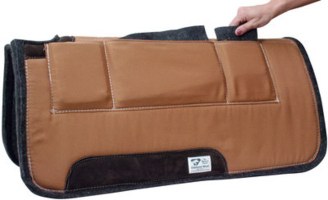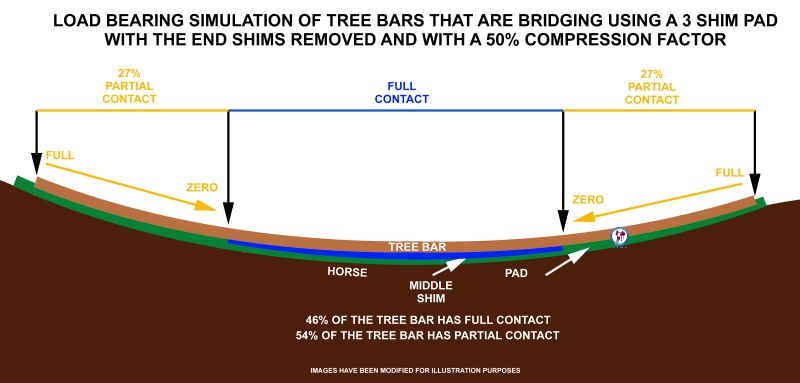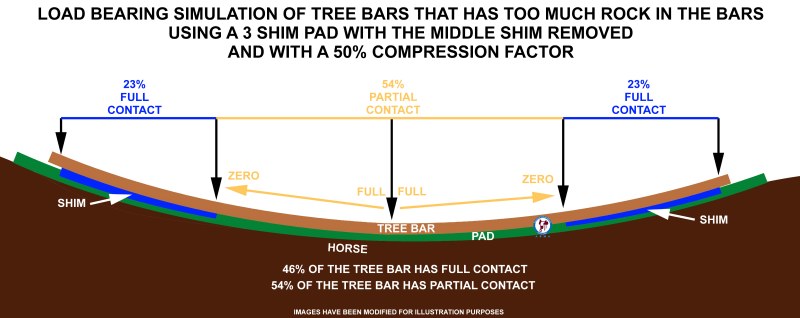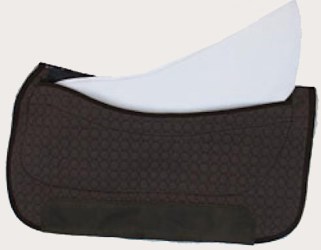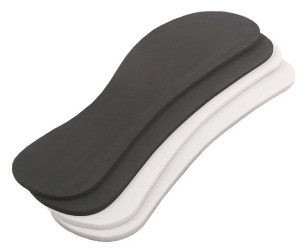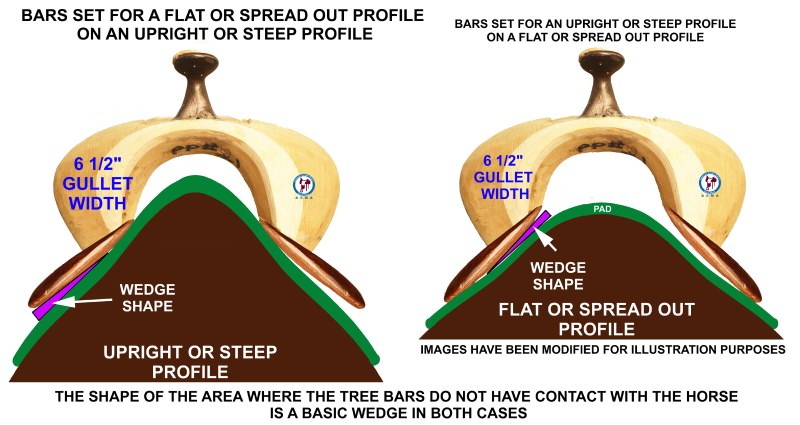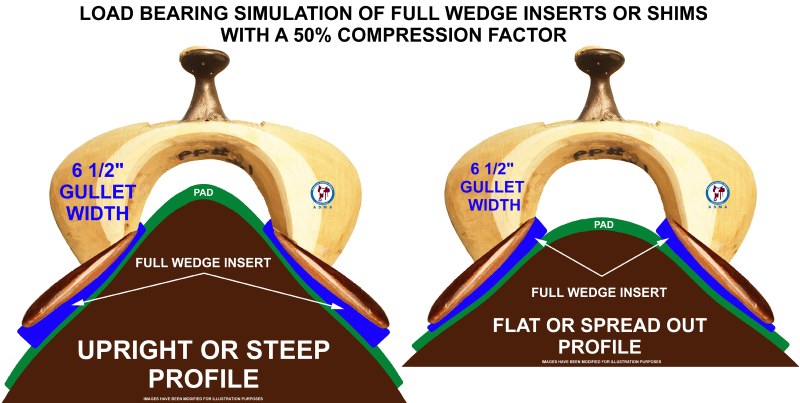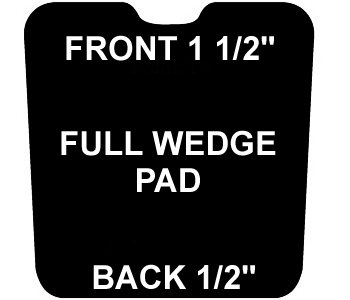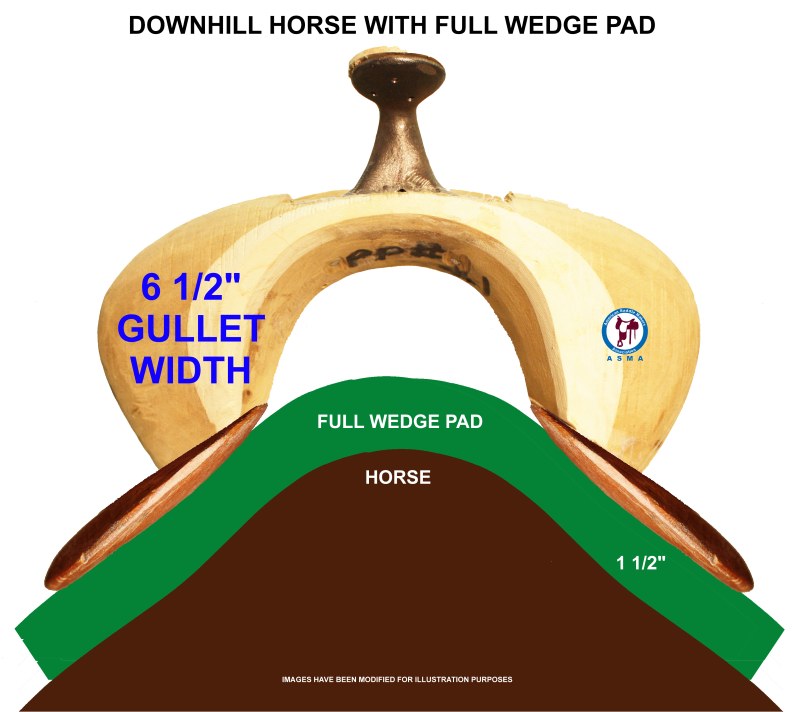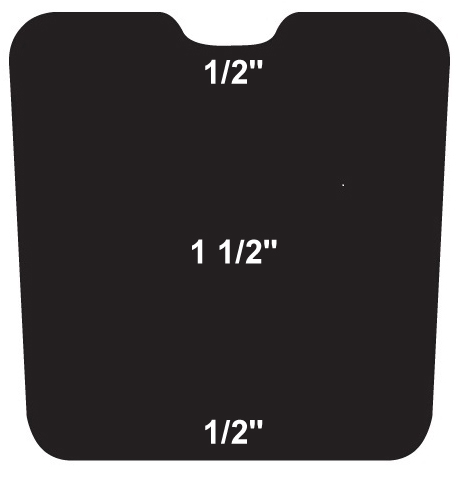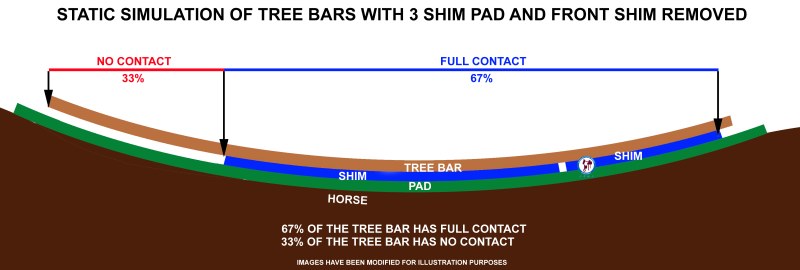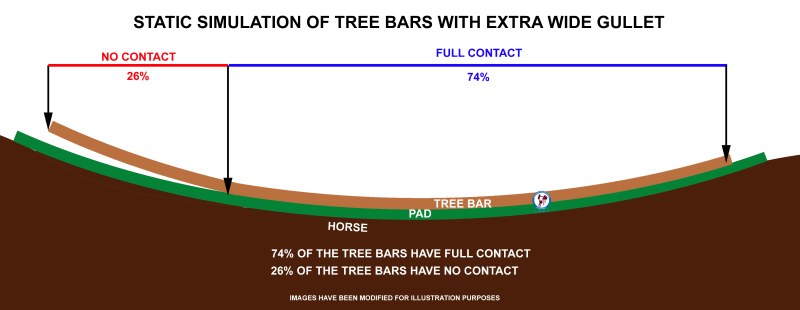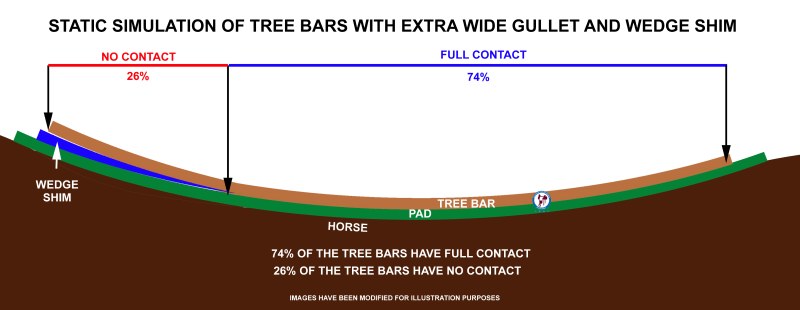 WITHER SHIMS WITHER SHIMS
|
SINGLE POMMEL OR WITHER PAD/SHIM
|
This concept is somewhat popular, as pressure in the wither area seems to be a common problem. The idea here is by adding the shim you will relieve pressure in the wither area and allow more movement in the shoulder. Also, some advocate this method as a solution for a down hill horse. The primary purpose of the tree bars is to distribute the rider’s weight (load vector) evenly over the horse’s back.
|
If a pommel or wither “shim” is used to relieve the pressure of an incompatible angle, the result is similar to a thicker pad or multiple pads. As illustrated in the example below:
|
|
If a pommel or wither “shim” is used to relieve pressure in the wither area from another saddle fit problem such as not enough relief in the front tip of the bar or to allow more movement for the shoulder, the result is positive in the angle or vertical plane. As illustrated in the example below.
|
While the pommel or wither “shim” works with the angle or vertical plane, possible problems can be seen in the horizontal plane.
|
|
Analysis of a single pommel or wither pad/shim
The idea here is by adding the shim you will relieve pressure in the wither area and allow more movement in the shoulder. Also, some advocate this method as a solution for a down hill horse. The primary purpose of the tree bars is to distribute the riders weight (load vector) evenly over the horse’s back.
In the above illustration the vertical plane or bar angle was addressed. When a pommel or wither pad/shim is added, the bearing surface of the tree bar in the horizontal plane or bar rock is decreased as indicated in the illustrations below.
|
The only points where the tree bars have contact with the horse’s back are at the back portion of the pad/shim and just the end portion of the back of the bars. This creates situation a similar to bridging, which has already been determined to be a negative factor in saddle fit.
|
|
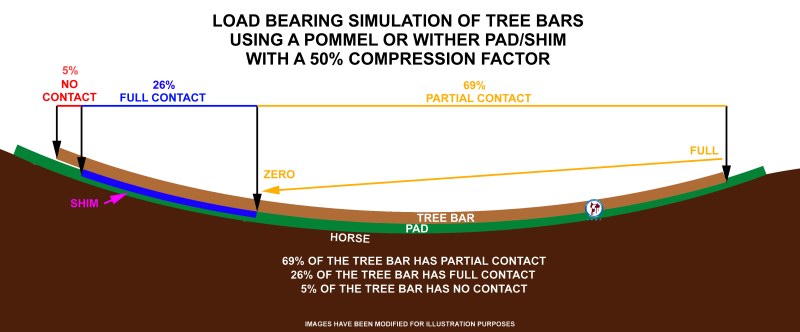
Once the rider is aboard, a load factor is transmitted to the bars of the tree and the pad is compressed and distributes the load factor. With the addition of the shim 5% of the bars have no contact with the horse, 69% has partial contact with the horse, and 26% has full contact with the horse. In the static simulation the tree bar is bridging. When the load is applied the shim and the pad compressed and some of the bridging is mitigated, but the major pressure is still concentrated in the area of the shim and the back end of the bar. The actual surface area of the bar that disburses the load is unknown without further detailed pressure mapping, but will be probable less than calculated.
Also, the addition of the shim changes the attitude of the saddle. If the purpose of the shim is to compensate for a downhill horse the shim will improve the level of the saddle. The pressure on the wither caused from the downhill situation will be mitigated, but may be substituted by the pressure created by the shim. If the saddle is level, the addition of the shim will raise the front of the saddle into the uphill horse problem. The uphill situation causes the load vector to transfer more pressure to the back of the bars. So some of the pressure on the front will eliminated but more pressure will be added to the back of the bar.
Again, saddle fit is subjective. For a barrel race this may be within tolerances, but not within tolerances for a day of trail riding in the Bob Marshall wilderness.
|

|
NOTE: One must always keep in mind that all of this information is based on a static analysis. Saddle fit is dynamic and when horse and rider are in motion other factors can come into play which will change the results.
|
|
Load bearing analysis of partial contact with the horse’s back
The purpose of the bars of the saddle tree is to disburse the rider’s weight evenly on the horse’s back. If a rider weighs 175 pounds and the area of the tree bars are 208 square inches, then each square inch of the bars in theory disburses .84 pounds. In this simulation, the length of the bars has 95% contact with the horse’s back or 198 square inches which equates to .88 psi. Around 69% of the bar has partial contact with the horse’s back. The problem is that the pressure is not even, in that the contact is partial going from full pressure to zero pressure. In this example, the area of full contact has about 60% more pressure at 1.43 psi than the even pressure of .88 psi at the back of the bars. At the front just in behind the shim instead of even pressure of .88 psi there is zero psi.
|
|
WEDGE POMMEL OR WITHER PAD/SHIM
|
|
|
Some have anticipated these problems and have opted for a wedge shaped pommel or wither pad/shim. For the angle or vertical plane the results are basically the same as the pad up simulation and the single shim simulation.
|
|
Analysis of a wedge shaped pommel or wither pad/shim
When a wedge shaped pommel or wither pad/shim is used, again the result are similar to a single pommel or wither pad/shim. When a wedge shaped pommel or wither pad/shim is added, the bearing surface of the tree bar in the horizontal plane or bar rock is decreased as indicated in the illustrations below.
|
In this simulation, only points where the tree bars have contact with the horse’s back are at the front portion of the pad/shim and just the end portion of the back of the bars. As with the single shim, this creates situation a similar to bridging, which has already been determined to be a negative factor in saddle fit.
|
|
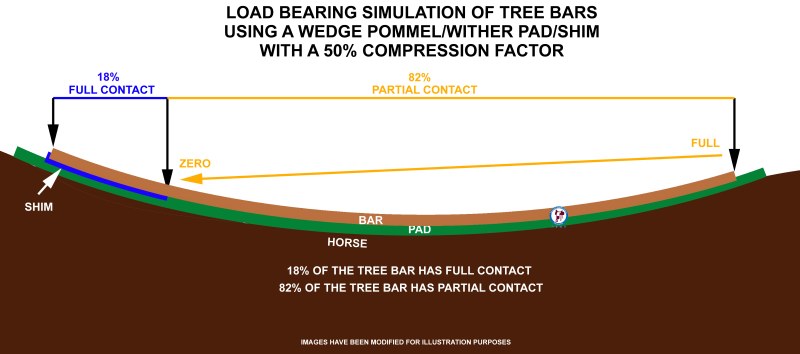
With the wedge shaped shim, 82% has partial contact with the horse, and 18% has full contact with the horse. In the static simulation the tree bar is bridging. When the load is applied the shim and the pad compressed and some of the bridging is mitigated, but the major pressure is still concentrated in the area of the shim and the back end of the bar. The actual surface area of the bar that disburses the load is unknown without further detailed pressure mapping, but will be probable less than calculated.
As with the single shim, the addition of the shim changes the attitude of the saddle. If the purpose of the shim is to compensate for a downhill horse the shim will improve the level of the saddle. The pressure on the wither caused from the downhill situation will be mitigated, but may be substituted by the pressure created by the shim. If the saddle is level, the addition of the shim will raise the front of the saddle into the uphill horse problem. The uphill situation causes the load vector to transfer more pressure to the back of the bars. So some of the pressure on the front will eliminated but more pressure will be added to the back of the bar.
Again, saddle fit is subjective. What works for one may not fit another’s needs.
|

NOTE: The position the shims can increase or decrease their effectiveness. In the simulations, care has been taken to follow the instructions on how to use the shims.
|
|
DOUBLE POMMEL OR WITHER PAD/SHIM
|
Again, for the angle or vertical plane the results are basically the same as the pad up simulation and the single shim simulation
|
Analysis of a double pommel or wither pad/shim
When a double pommel or wither pad/shim is used, the result is similar to a single pommel or wither pad/shim. In this example, the shims are staggered reflecting the instructions on how to place the shims. In reality, the bearing surface is decreased more than the single pad/shim, as indicated in the illustrations below.
|
With two staggered shims, only points where the tree bars have contact with the horse’s back are where both shims are together and just the end portion of the back of the bars. This creates a situation similar to bridging, which has already been determined to be a negative factor in saddle fit.
|
|
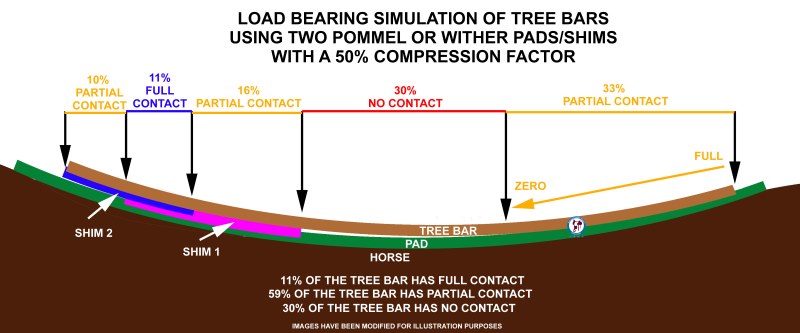
When two shims are used, 11% of the tree bars have full contact with the horse, 59% of the tree bars have partial contact with the horse, and 30% of the tree bars have no contact with the horse. In the static simulation the tree bar is bridging. When the load is applied the shims and the pad are compressed and some of the bridging is mitigated, but the major pressure is still concentrated in the area of the two shims are together and the back end of the bar.
As with the single shim, the addition of the two shims changes the attitude of the saddle. If the purpose of the shim is to compensate for a downhill horse, the shim will improve the level of the saddle. The pressure on the wither caused from the downhill situation will be mitigated, but may be substituted by the pressure created by the shims. If the saddle is level, the addition of the shims will raise the front of the saddle into the uphill horse problem. The uphill situation causes the load vector to transfer more pressure to the back of the bars. So some of the pressure on the front will be eliminated but more pressure will be added to the back of the bar.
Again, saddle fit is subjective. For one rider this solution may be acceptable, while with another rider it is a deal breaker.
|

|
 PADS WITH MULTIPLE SHIMS PADS WITH MULTIPLE SHIMS
|
|
Other common problems are saddles that are bridging and saddles that have too much rock. The idea here is one can add or subtract shims as the case requires.
In analyzing pads with multiple shims, it is assumed that the bar angle is compatible. A saddle with an incompatible bar angle and that is either bridging or having too much rock is for all practicable purposes will not be able achieve a positive saddle fit.
|
Analysis of pads with multiple shims where a saddle is bridging
When a saddle is bridging, only the ends of the bars have contact with the horse, as illustrated in the simulation below.
|
The classic bridging situation. All the pressure or weight is on the ends of the bars. In the next simulation the shims on each end have been removed.
|
|
With the end shims removed, space is created to allow the ends of the bars to settle when the load is applied and the middle shim fills in the majority of the void in the middle of the bar with mostly full contact at around 46%. The ends of the bars have partial contact at 27% each. This gives about 73% of the bars disbursing the load.
|
|
Analysis of pads with multiple shims where a saddle has too much rock
When a saddle has too much rock, only the middle of the bars has contact with the horse, as illustration in the simulation below.
|
With too much rock on the bars all the pressure or weight is in the middle of the bars. This simulation indicates that about 25% of the tree bars have contact with the horse’s back.
|
|
With the middle shim removed, space is created to allow the middle portion of the bar to settle when the load is applied and the end shims fill in the majority of the voids at each end in the middle of the bar. The ends of the bars have full contact at 23% each. With the middle of the bars having about 54% of partial contact. This translates to an effective area of the bars disbursing the load in the neighborhood of around 75%. While not perfect. 75% is way better than the 25% on the original simulation.
|
|
The three shim system shows positive results in both simulations. But as always, it is up to the rider to decide if this level of saddle fit is acceptable.
|
|
 PADS WITH FULL SHIMS PADS WITH FULL SHIMS
|
A variation on the theme of additional pads are pads with full shims or inserts. These pads can have shims of different thicknesses and densities. In some cases the shims are built into the pad.
This concept is basically the same as multiple pads and the results are the same.
|
As always, there are exceptions to the rule. When the angle of the tree bars and the angle of the profile of the horse are incompatible, there are pressure points at the top of the bars and at the bottom of the bars. This leaves an area with no contact between the profile of the horse and the tree bars in the shape of a wedge.
|
|
There are cases of custom pads being made with full inserts or shims in the shape of a wedge as indicated below.
|
|
|
|
The full wedge insert or shim fills in the void in both cases and the bars have full contact with the horse’s back. When the rider is aboard how effective the insert or shim is in disbursing the load vector will depend upon the material used in the insert. In theory this is a positive solution.
As with other pads and shims by adding additional padding, the rider’s center of gravity is raised, causing the rider to feel top heavy and out of balance. The additional padding can also cause the saddle to roll more than normal.
|
|
 PADS FOR SPECIFIC SADDLE FIT PROBLEMS PADS FOR SPECIFIC SADDLE FIT PROBLEMS
There are pads that have been developed for specific saddle fit problems. One would be a special pad for the downhill horse and another one would be for a saddle that is bridging.
|
THE DOWNHILL HORSE
The downhill horse is a conformation in which the wither is lower than the hips.
|
This causes the saddle to run “downhill.” In the English discipline a common problem is the uphill horse. With the somewhat long backs of thoroughbreds and warmbloods, the back or cantle of an English saddle has a tendency to rest in the low area of the back profile causing the saddle to run uphill. In other words the cantle is lower than the pommel. To solve this problem, the English riders use a wedge pad or lift pad that is thicker in the back than the front.
To solve the problem of the downhill horse, the western discipline uses the same principle, but in reverse.
|
This style lifts up the pommel and levels out the saddle and there is even contact with the horse the entire length of the bar.
|
With the additional thickness of the pad at the pommel, the rider’s center of gravity is raised (see the example below), causing the rider to feel top heavy and out of balance. The additional padding can also cause the saddle to roll more than normal.
|
|
THE BRIDGING SADDLE
When a saddle is bridging, only the ends of the bars have contact with the horse, as illustrated in the simulation below.
|
Some describe this situation as a sway back horse. To solve the problem the pad is thicker in the middle.
|
This pad fills in the void between the tree bars and the horses’ back giving contact with the horse the entire length of the bar.
|
As with other situations, the rider’s center of gravity is raised, which may cause the rider to feel top heavy and out of balance. This additional padding can also cause the saddle to roll more than normal.
|
|
As noted previously, a concept has developed in that in allowing more relief and movement in the shoulder and scapula leads to better performance. This has lead to changes in the saddle trees and new padding systems and practices. We will address two of the most popular methods.
One of the popular methods to give more relief in the shoulder is using a three shim pad system. The idea here is to remove the front shim, as illustrated below.
|
As one can see, the front of the tree bars have not contact with the pad or horse in the swell or wither area. The shoulder has plenty of room to move with out restriction. Once a load vector is applied, the results are the same, as indicated below:
|
 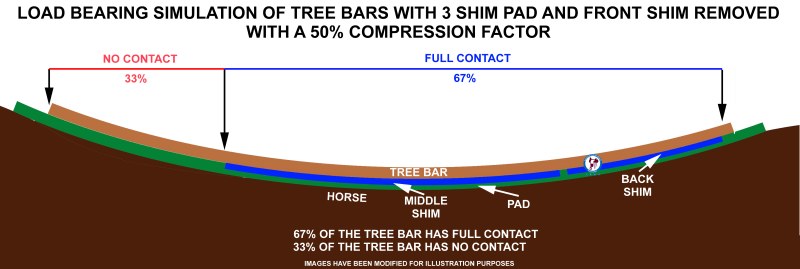
The purpose of the bars of the saddle tree is to disburse the rider’s weight evenly on the horse’s back. If a rider weighs 175 pounds and the area of the tree bars are 208 square inches, then each square inch of the bars in theory disburses .84 pounds. In this simulation, the length of the bars have 67% contact with the horse’s back or 139 square inches which equates to 1.26 psi, which is about 50% more pressure on the portion of the bars that have contact with the horse.
The above example is static and the load vector is centered. Once the horse and rider are in motion, saddle fit becomes dynamic. For example: If the rider leans forward into a turn in a speed event, then the load vector is moved forward as indicated in the following example.
|
 
With the front of the tree bars having no contact with the horse, when the load vector is moved forward more pressure is applied to the front of the tree bars. Because the front of the bars do not have positive contact with the horse, the load vector will cause the front tips of the bars to start applying downward pressure on the pad and horse. This will cause the back of the bars to lift and decrease the pressure in that area. This results in a pressure point at the front tip of the bars and a pressure point at the leading edge of the middle shim. So this could compromise the intended goal of relieving pressure in the whither or shoulder area. May work for some and not others.
|
|
An other popular method to give more relief in the shoulder is widening the gullet of the saddle tree. While 6 1/4" to 6 3/4" are the most common, some are advocating gullets widths in the area of 7 ½" and up to 9". This concept is illustrated below.
|
As one can see, the front of the tree bars have not contact with the pad or horse in the swell or wither area, which is similar the previous example. In anticipation of the problems with the 3 shim pad system a wedge wither or pommel pad has been added to fill in the void created by the wide gullet in the below simulation.
|
Once a load vector is applied, the results are the same what similar, as indicated below:
|
 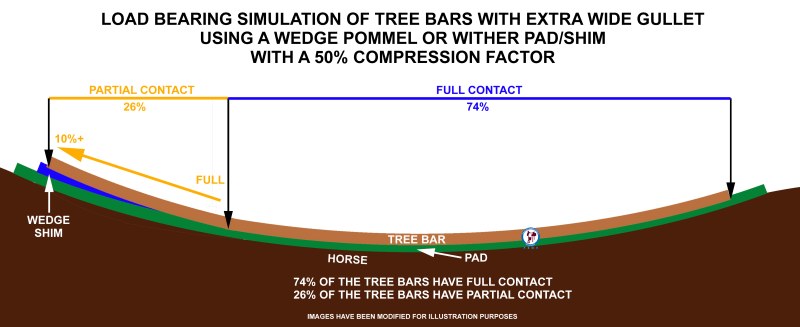
With the load vector applied there is 74% of the tree bars with full contact and 26% with partial contact. As always, the purpose of the bars of the saddle tree is to disburse the rider’s weight evenly on the horse’s back. If a rider weighs 175 pounds and the area of the tree bars is 208 square inches, then each square inch of the bars in theory disburses .84 pounds. In this simulation, the length of the bars have 74% contact with the horse’s back or 154 square inches which equates to 1.14psi, which is about 35% more pressure on the portion of the bars that have contact with the horse. Also there is partial contact at the front which will reduce the psi to some extent.
So far our example is static and the load vector is centered. Once the horse and rider are in motion saddle fit becomes dynamic. For example: If the rider leans forward into a turn in a speed event as stated before, then the load vector is moved forward as indicated in the following example.
|
 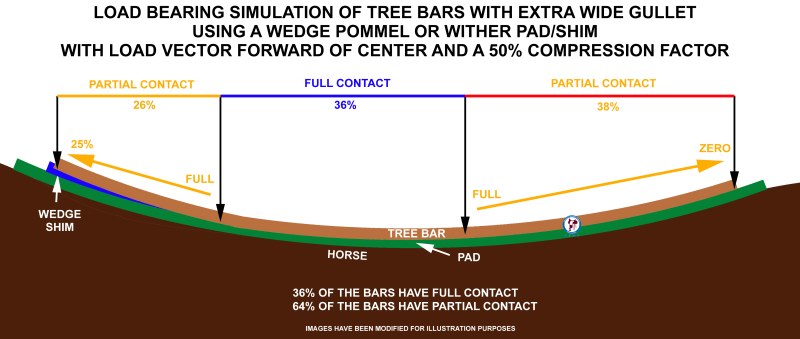
With the front of the tree bars having only partial contact with the horse, when the load vector is moved forward more pressure is applied to the front of the tree bars. Because the front of the bars do not have positive contact with the horse, the load vector will cause the front tips of the bars to start applying downward pressure on the pad and horse. This will cause the back of the bars to lift and decrease the pressure in that area. This results in the full contact of 74% being reduced to 36% and 38% of partial contact being created. With both the front and back of the bars having partial contact, the majority of the load vector is concentrated in the middle of the bars. This creates a situation similar to the bars having too much rock, which has been identified as a negative saddle fit. This illustrates how complex saddle fit can be. One solution creates another problem.
In this case does the advantage of more room for the shoulder to move freely out way the negative concentration of pressure in the middle of the bars?
|

|
GENERAL CONCLUSIONS
Pads and padding will in general mitigate negative saddle fit problems, but will not solve them.
There are situations where pads designed for a specific problem are successful to a degree. The rider must determine what solution fits their needs the best.
With saddle fit being a complex issue, further study and research is needed to prove or disprove the various concepts and ideas on solving negative saddle fit.
|
|
 |
